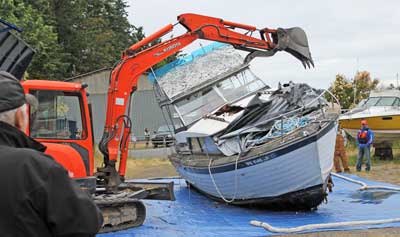A new twist to a long-standing state pollution prevention program made a hearty debut last week on the waterfront of Friday Harbor. By all accounts, it proved a smashing success.
Ken Norris wasn’t going stick around to witness the lift-off from start to finish, however, because for him, the launch of the derelict vessel removal program’s newest feature, the “turn-in” option, signaled a most bittersweet goodbye.
“It’s a mixed blessing to have the state take care of it for me,” Norris said of the fate of the 28-foot wooden boat that for the better part of 20 years had been home-sweet-home and the embodiment of a cherished dream.
His means to maintain the boat slipped away in the fallout from a severe leg infection several years ago and, ultimately, orders by his doctor to abandon ship.
“I couldn’t have done it any other way,” he said.
Managed by the Washington Department of Natural Resources, in partnership with local government entities, like counties, cities and publicly owned port districts, the Derelict Vessel Removal Program has had its own share of ups and downs since it was first founded in 2002.
In San Juan County, for example, the program collapsed when budget-wary county officials opted against setting aside $10,000 or so—the local “match” required by DNR for removal and demolition costs—in the wake of the recent economic recession.
Under the program, the state, through DNR, covers 90 percent of the cost associated with removal, transport, demolition and disposal of boats, and docks and floats, that have fallen into disrepair and that have either been abandoned or are in imminent threat of sinking. Dozens of boats in local waters had been identified as “derelict” and candidates for removal at that time.
Then, about three years ago, San Juan Island’s Marc Forlenza, as then-commander of the Friday Harbor Power Squadron, raised $6,500 from boaters and other private sources as a would-be part of the matching fund, which former local program coordinator and Public Works employee Joanruth Baumann used to persuade the county to chip in $5,000, which in turn would resurrect local funding for the program in the San Juans.
The local program has flourished since and in large part because of its resurrection. With Forlenza now at the helm, and a $325,000 grant from Puget Sound Partnership in tow, it has become a model for state and Forlenza works with other communities to help shore up and keep their own programs afloat and adequately funded.
Still, the “Turn In Option” adds a new wrinkle and incentive to the program. It’s designed to take boats of 45 feet or less, which have fallen into disrepair, off the hands of Washington residents who lack the financial resources to repair and maintain them.
Forlenza intends to make sure that the San Juans gets its share and local businesses have a chance to benefit before the funding set aside by the state dries up. And, he noted, that the cost to demolish, town and dispose of Norris’ 1969 Owens-built boat proved less expensive by having it done by a team of local contractors than it would have had a large regional company, a specialist in the field, taken the project on.
“It’s not all about keeping it local,” Forlenza said. “but it’s nice to have it that way as much as we can. I’d like to get a team in place for this kind of thing.”
The legislature allocated $4.5 million for the derelict vessel program as part of the 2013-15 state budget, (the majority being a one-time appropriation to help reduce a backlog of derelict vessels) of which roughly $200,000 is earmarked for the turn-in program. That translates into $100,000 a year to cover the cost of the voluntary program, noted Tammy Robbins, manager of the vessel turn in program.
Robbins said DNR has received about a dozen applications since the program went live on May 1. The bill to tow, demolish and dispose of the average boat is about $9,000, she said.
“We’re trying to find the best value for the money,” she said. “Hopefully as we get going we can do ‘batch’ removals to consolidate costs and in that way save even more money. So far, we’re off to a good start.”




